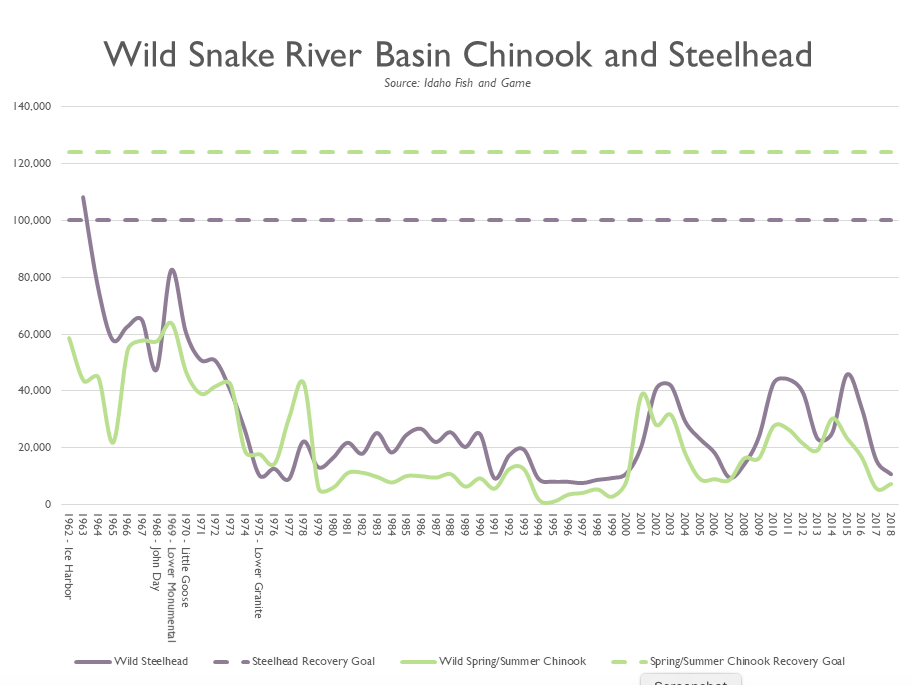forum
library
tutorial
contact

Salmon, Dams:
We Need Both
by Wanda Keefer
Spokesman-Review, May 5, 2019
|
the film forum library tutorial contact |

|
Salmon, Dams:
by Wanda Keefer
|
Climate change impacts ocean conditions as well as ambient temperatures.
Salmon spend 75% of their lives in the ocean.
 Salmon. Dams. Both exist today. Changes to that status would impact everyone. Higher energy costs, increased freight movement on roadways and rail, and taking away carbon-free hydropower could negatively affect your quality of life.
Salmon. Dams. Both exist today. Changes to that status would impact everyone. Higher energy costs, increased freight movement on roadways and rail, and taking away carbon-free hydropower could negatively affect your quality of life.
If dam opponents had their way and the Snake River dams were removed, barging would end. By eliminating barging -- the most efficient, reliable, safest mode of cargo transport -- wheat and other products would need to be transported by rail cars or semi-trucks. It may be necessary to double or triple tracks to meet future needs.
We already have a shortage of truck drivers. Over 135,000 additional trucks annually would be needed to move the cargo that now moves by barge. Imagine you and your family sharing the roadways with that many trucks. To move what we grow and make in Eastern Washington and Idaho, we need all three modes of transportation -- road, rail, and river -- working at all times. The future of safe and efficient transportation is at stake. So is our economy.
Some policy-makers miss a key question in their analysis of salmon versus dams. Presently, they ask: How can we make communities whole if the four lower Snake River dams are removed?
The question they should ask is: Would the removal of the four Lower Snake River dams result in more robust fish returns? The answer to that question is a resounding "NO." Dam removal could make the situation worse by increasing the impacts of climate change.
Fish survival rates at the dams today are above 95% -- rates equaling or exceeding those of un-dammed rivers. Plus, the dam breaching extremists forget to mention that only four of the thirteen threatened or endangered species of fish come into the Snake River. The other nine are purely Columbia River runs. Removing Snake dams will do nothing for those nine runs.
 Climate change is the true enemy of migratory fish.
Climate change is the true enemy of migratory fish.
Northwest families and businesses have paid for fish passage, habitat restoration and hatchery improvements through their electric bills. Decades of collaborative work has been completed by federal agencies, states, Northwest tribes, and others. In 2014, all-time record salmon returns occurred, building on a decade of improved runs. In 2014, coho fishing opened for the first time in decades.
Habitat and hatchery improvements have continued. Logically, fish counts should increase, right? But something else happened: Weather.
In early 2015, a nearly snow-free winter limited snowmelt for rivers. The summer of 2015 was the hottest on record for the Northwest -- heat but no rain. Widespread wildfires resulted. Sockeye salmon began dying because the species are more sensitive to water temperature. Biologists and river managers determined that 90% of 2015 Snake River sockeye salmon died before reaching one of the lower Snake River dams, due to warmer water temperature.
I repeat: 90% of the sockeye fish migrating upstream died. They died because the water was unusually warm because climate change reared its ugly head. The fish died before reaching any of the lower Snake River dams that are targeted for removal.
Climate change impacts ocean conditions as well as ambient temperatures. Salmon spend 75% of their lives in the ocean.
The dams provide benefits beyond transportation. Those include irrigation, tourism, recreation, and carbon-free power generation. This amazing river system helps feed the world. Wind and solar power are integrated into our power delivery system because dams provide firm base power for keeping our lights on and our refrigerators running. Replacing dams requires using fossil fuels and creating carbon emissions or nuclear energy for base load.
In a future where the supply of and access to water may be a challenge, dams will be a key solution.
Policymakers in Washington and Idaho have created two new forums to look at dam breaching. If history is any guide, these forums will be stacked with single issue, anti-dam advocates whose vision includes less carbon-free power, a switch to inefficient modes of transportation at public safety expense, and an expensive "solution" that will not bring back our salmon runs.
Where will we be 20, 30 or 40 years from now if emotions guide policy, instead of science?
Will you be part of the dialogue? I know I will.
learn more on topics covered in the film
see the video
read the script
learn the songs
discussion forum
